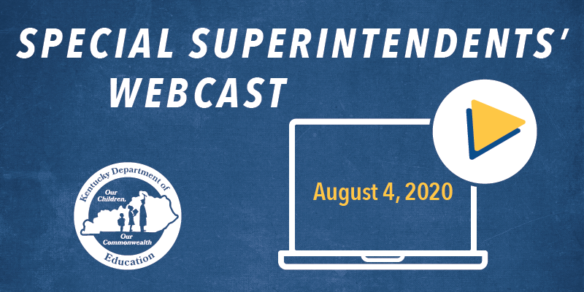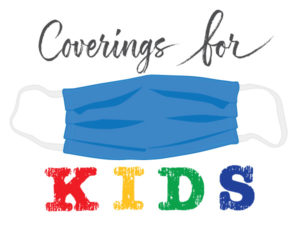
By Jim Gaines
jim.gaines@education.ky.gov
Kentucky First Lady Britainy Beshear and Lt. Gov. Jacqueline Coleman are teaming up to encourage donations of cloth face masks to school districts across the state.
The Coverings for Kids program will start accepting donations of child- and adult-sized masks for students and staff on Aug. 11, Beshear said during the Aug. 4 Special Superintendents’ Webcast. Donors can buy masks to donate or make them at home. The masks will be available free to all students, educators or school staff who find themselves without a mask or need to replace one during the day, Beshear said.
 She recommended that school districts establish a central drop-off location to accept donations and distribute the masks in whatever way makes most sense for local needs.
She recommended that school districts establish a central drop-off location to accept donations and distribute the masks in whatever way makes most sense for local needs.
Districts starting the school year with non-traditional instruction (NTI) or that transition to NTI during the year also can participate.
Questions can be emailed to Lindsay Bloom.
Sports Updates
Julian Tackett, commissioner of the Kentucky High School Athletic Association (KHSAA), updated superintendents on plans for managing fall sports.
“We continue to work toward a start of practice on August the 24th, with a goal of trying to play some type of competition September 7th,” he said.
The KHSAA board is working on a “Healthy at Sports” guidance document on how to conduct games, Tackett said, which will be submitted to the Kentucky Department for Public Health (DPH) for comment. He hopes to have a final version, spelling out requirements and options, sent to school districts before Aug. 24.
“We’re trying to juggle the virus impact, the community impact and the education impact,” Tackett said.
It’s “without question” that masks will be required for spectators, and districts should begin calculating their sports facilities’ capacity in light of the latest restrictions on crowd size and occupancy, he said.
Barriers and Ventilation
Several superintendents submitted questions on whether plastic shower curtains could be used as barriers in classrooms. Dr. Connie White, DPH deputy commissioner, said that although DPH now allows securely mounted plexiglass shields for protection in addition to masks and 6 feet of distance, shower curtains were no substitute.
“When we’re talking plexiglass, we’re talking plexiglass,” she said. Shower curtains may be flammable and, when burning, emit toxic fumes, White said.
Medical supply companies may offer non-flammable curtains, but districts should check with fire marshals before considering them, she said.
There are lots of public suggestions for improvised room dividers, but fumes aren’t the only potential issue, said Kay Kennedy, education consultant in the Kentucky Department of Education’s (KDE) Division of District Support. They also might make emergency evacuation more difficult, so schools should ask fire marshals about that too, she said.
Other superintendents asked what they could do to improve air quality in poorly ventilated rooms, such as buying air filtration systems.
That’s possible, but schools must consider the room size and the system’s maintenance requirements, Kennedy said. The U.S. Centers for Disease Control and Prevention is recommending systems that meet high-efficiency particulate air (HEPA) filter standards, she said. Districts can email her with specific questions.
White said it will help any time a district can open doors or windows.
More Guidance
Guidance documents on school libraries and allowable class size exemptions will be released Aug. 10, said Kelly Foster, KDE associate commissioner in the Office of Continuous Improvement and Support. Coming Aug. 17 will be guidance from the Kentucky Department for Behavioral Health, Developmental and Intellectual Disabilities on how to hold virtual training for suicide prevention.
Schools that have site-based decision-making (SBDM) councils can make local adjustments to class-size policies via the SBDM council without an additional state waiver, Foster said. Districts should look at their SBDM and school board policies for that already may exist on the issue, she said.
If a school or individual program doesn’t have an SBDM, the district can email Foster for an exemption form.
MORE INFO …
- Aug. 4 Special Superintendents’ Webcast
- KDE’s COVID-19 webpage
- KDE’s COVID-19 Reopening Guidance webpage
- Kentucky COVID-19 Hotline (800) 722-5725



Leave A Comment